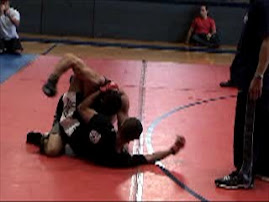 Sporting traditionalists frequently grumble when chief administrators alter sporting structures as they cater to new fans' demands. Traditionalists tend to argue that when sporting rules are changed or athletic skills are abandoned, we are witnessing a commodification of sport that values theater and spectacle over virtuous athleticism (Sewart, 1987).
Sporting traditionalists frequently grumble when chief administrators alter sporting structures as they cater to new fans' demands. Traditionalists tend to argue that when sporting rules are changed or athletic skills are abandoned, we are witnessing a commodification of sport that values theater and spectacle over virtuous athleticism (Sewart, 1987).In the sport of mixed martial arts (MMA), the debate is a bit more convoluted, calling for a somewhat technical and academic examination.
Despite MMA's mere 17 year history, supporters and critics have quarreled extensively over the sport's trajectory and the way MMA may symbolize a moral threshold for societal violence. However, in MMA we have seen a public effort to formalize rule structure and secure governmental regulation since the sport's 1993 inception, both before and after Zuffa, LLC took over the UFC in 2001.
Sports theorists (van Bottenburg & Heilbron, 2006) have suggested that as MMA continues to grow (or stagnate), it can follow four overarching pathways, which are not necessarily mutually exclusive:
- Abolition and demise: states or countries may pass or maintain legislation that bans MMA (e.g., the push back seen in New York State, Vancouver, and Germany). Demise may also include the folding of MMA organizations due to financial concerns (e.g., EliteXC).
- Underground: abolition and demise may contribute to illegal, unregulated MMA competitions hidden from state officials (though underground competitions can also take place in regions where MMA is legal).
- Re-sportization: increased state regulation with stricter rule sets that would focus not only on in-ring/cage competition, but also on refereeing, athlete health prior to and after competition, and fighter-manager-promoter relationships. In contrast with many other sports, MMA (in particular the UFC) has overtly pushed for state regulation in recent years (Smith, 2010).
- Spectacularization: "...a shift of attention away from fighting skills to the show and spectacle surrounding the events" (p. 277). The recent match between Cris Santos and Jan Finney stands as an example here. The match was so uneven, some argue it never should have been allowed in the first place, but was scheduled nonetheless so fans could watch Santos' compete at all.
While all four pathways are occurring simultaneously across different MMA organizations and in different regions of the world, the modest academic literature published to date on MMA argues re-sportization is the more common trajectory being followed thus far.
Garcia and Malcolm (2010) argue in their essay, "Decivilizing, civilizing or informalizing: The international development of Mixed Martial Arts," that although MMA promoters tend to publicly advertise MMA competitions as dangerous and appear excessively violent in order to draw in more fans, sporting violence in MMA has actually decreased. They suggest that while MMA, like all combat sports, is inherently violent and can be dangerous, the violence now manifests in a highly controlled environment (when properly regulated).
The staunchest defense of MMA, however, has come from Maher's (2010) work, which meticulously details how regulation of MMA has sought to improve athlete safety through improved rules, oversight of performance enhancing drugs, and medical safeguards. Maher also argues MMA organizations have improved in promoting fair contests (as opposed to unfair matches booked to promote a more likely winner), and in restricting conflicts of interest between promoters, managers, and fighters.
Maher's very thorough work, however, focuses too heavily on the UFC. As noted previously, spectacularization still transpires in MMA, which does little to promote fighter safety. The most interesting questions Maher raises are whether or not (1) MMA can secure federalized, standardized regulation across the United States; and (2) fighters can coalesce to form a union that effectively advocates for their rights (questions I will be addressing in my next piece, and related to my last piece, "Marxist Mixed Martial Arts?").
Notably, all the above referenced work is theoretical or historical. Very little scholarly research has been conducted that relies on empirical research. In fact, the only empirical research conducted thus far relevant to the issue of spectacularization and fan desire has found that invested MMA fans do not want to see lopsided matches.
Kim, Andrew, and Greenwell (2009) surveyed MMA fans attending an amateur card in the American Midwest (N = 208) and an event held in South Korea (N = 229). In both sites, research subjects indicated that their primary motive for attending the event was their interest in the sport (i.e., they are an MMA fan and care about MMA). "Drama" ranked #2 among South Korean fans and #3 among American fans, meaning fans desired close competitions, not unfair, lopsided fights.
Among the 12 possible motives for attending the event, "violence" ranked #5 for Americans and #11 for South Koreans. These findings are especially important because they tell MMA promoters that fans want to see fights exemplifying high-level MMA skills between evenly matched, prepared opponents, not promotional "freakshows" that decrease fighter safety.
Let's give the fans what they want.
References:
Garcia, R. S., & Malcolm, D. (2010). Decivilizing, civilizing or informalizing: The international development of Mixed Martial Arts. International Review of the Sociology of Sport, 45 (1), 39-58.
Maher, B. S. (2010). Understanding and regulating the sport of mixed martial arts. Hastings Communication and Entertainment Law Journal, Winter.
Sewart, J. J. (1987). The commodification of sport. International Review for the Sociology of Sport, 22 (3), 171-191.
Smith, J. T. (2010). Fighting for regulation: mixed martial arts legislation in the United States. Drake Law Review, Winter.
van Bottenburg, M., & Heilbron, J. (2006). De-sportization of fighting contests: the origins and dynamics of no hold barred events and the theory of sportization. International Review for the Sociology of Sport, 41 (3/4), 259-281.

Blog search















